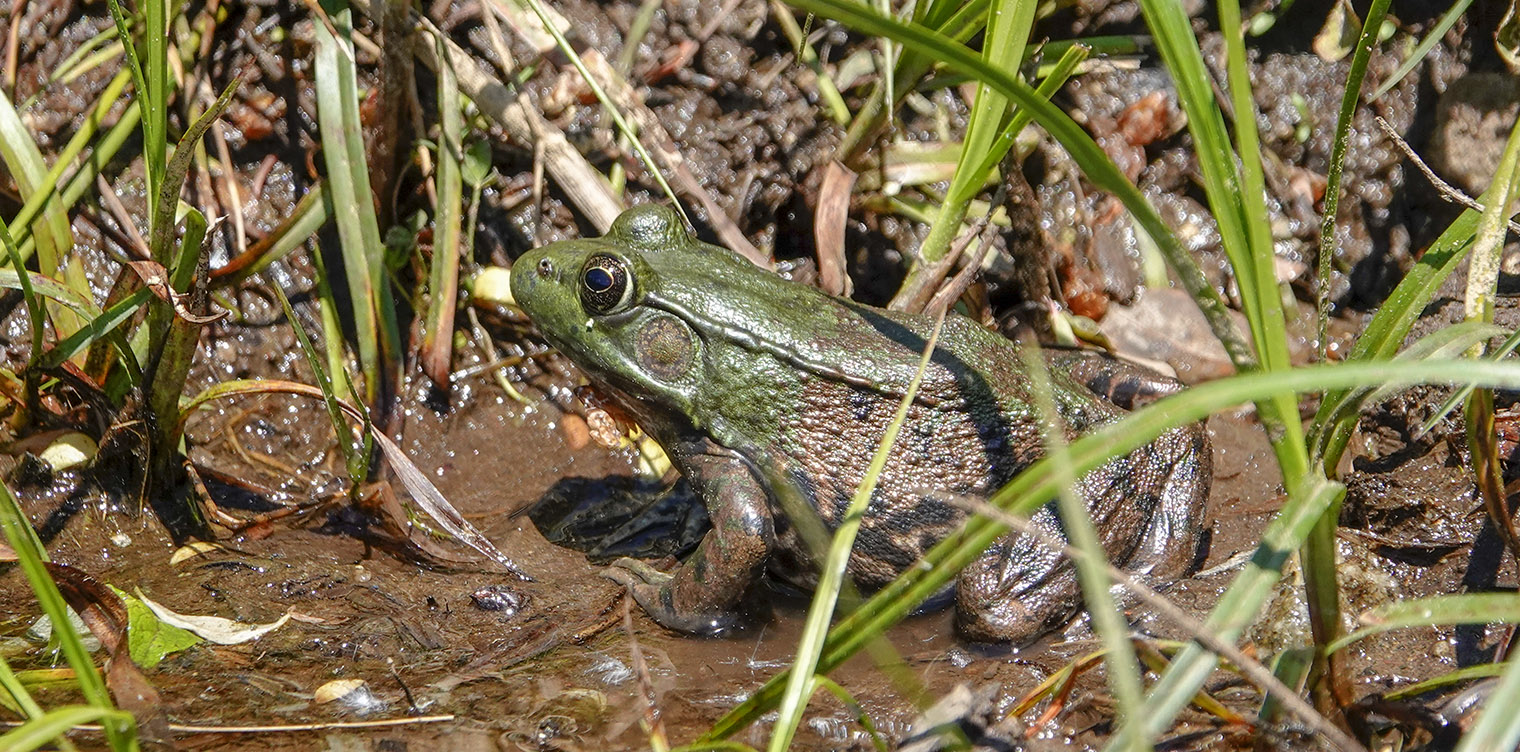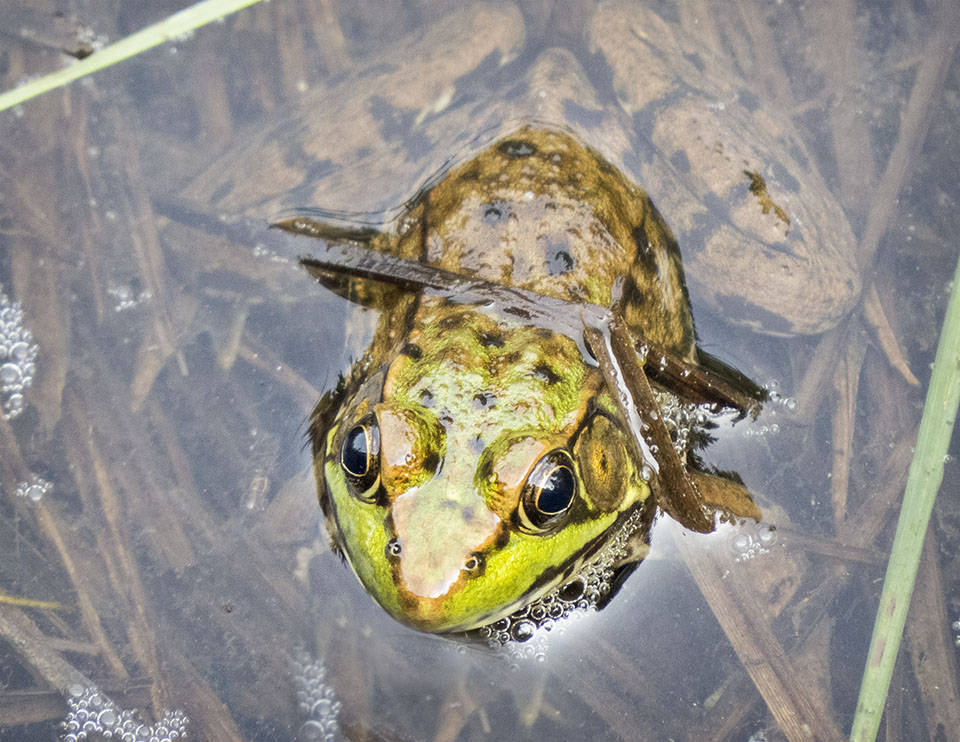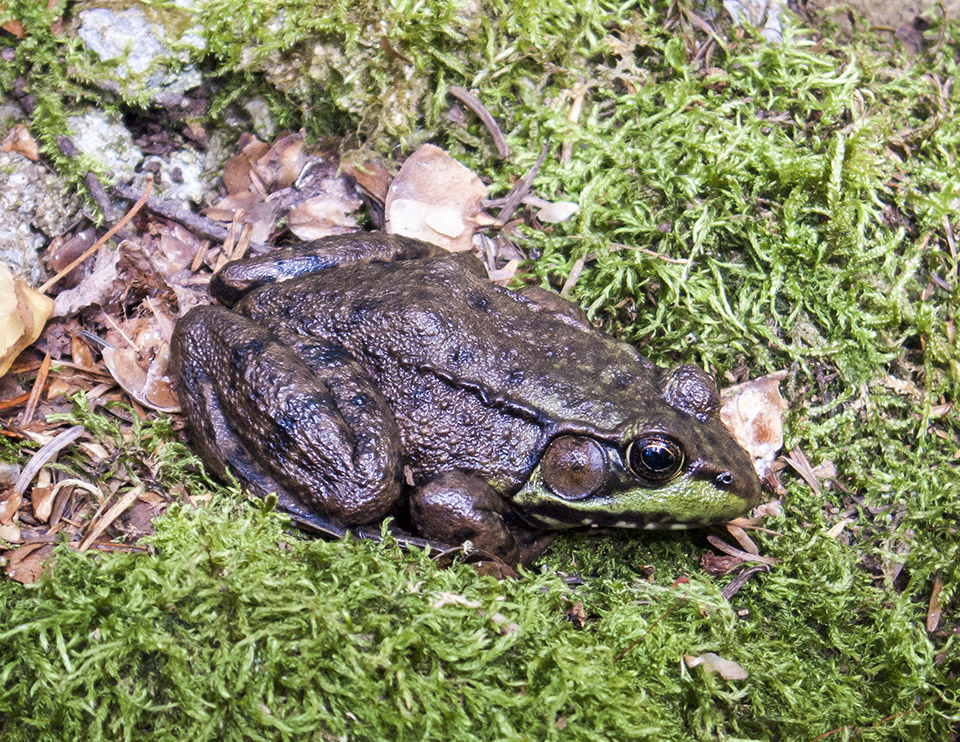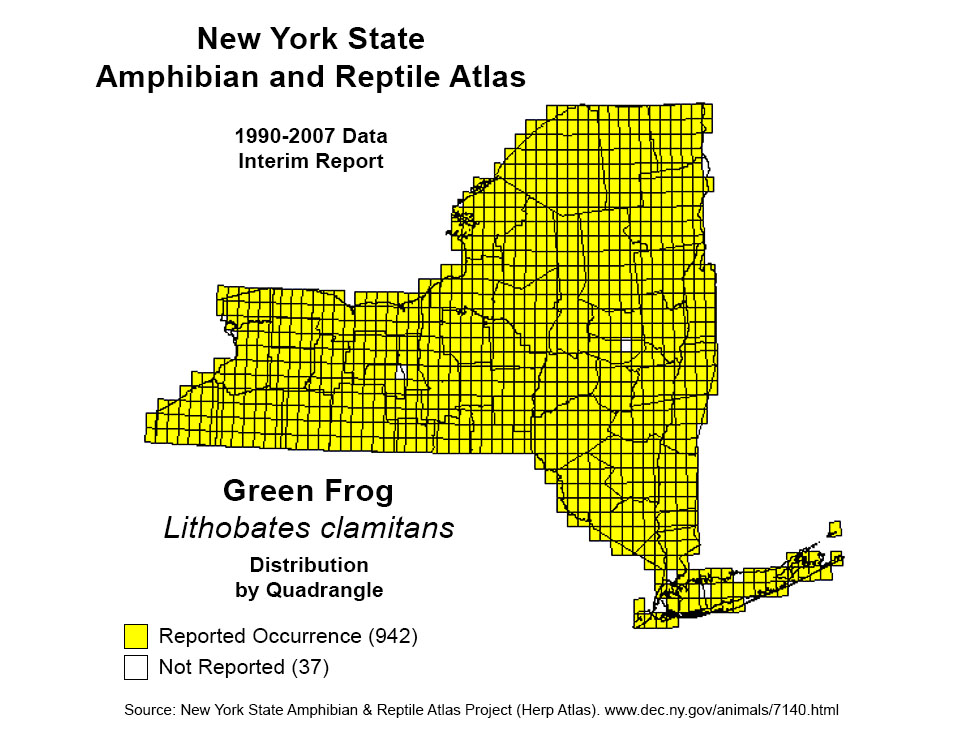Amphibians & Reptiles of the Adirondacks:
Green Frog (Lithobates clamitans)

The Green Frog (Lithobates clamitans), probably the most abundant frog in the Adirondack Park, is found in a wide variety of wetland ecological communities.
The Green Frog is currently assigned to the Lithobates genus. Other frogs native to the Adirondack Mountains also assigned to this genus include American Bullfrog, Mink Frog, Northern Leopard Frog, Pickerel Frog, and Wood Frog. The species name is derived from the Greek word "lith," meaning stone, and "bates," meaning one that walks or haunts The species name (clamitans) is Latin for "loud calling" – a reference to the loud squeak that the frog make when it leaps from danger.
As is the case for a number of other plant and animal species, the Green Frog's taxonomic status is the subject of ongoing debate in the scientific community.
- At one time, the Green Frog was assigned to the genus Rana. In 2006, as part of a larger revision, the Green Frog was removed from Rana and assigned to Lithobates, touching off a lively debate on whether the revision was justified and whether Lithobates should be recognized as a genus or as a subgenus within Rana.
- The debate remains unresolved with some authorities (i.e. the Integrated Taxonomic Information System; Amphibian Species of the World, Society for the Study of Amphibians and Reptiles) identifying the species as Lithobates clamitans and others (i.e. AmphibiaWeb) continuing to list the species as Rana clamitans.
At one point, two subspecies of Lithobates clamitans were recognized. Ours fell into the subspecies Lithobates clamitans melanota (Northern Green Frog). These subspecies are no longer recognized.
Green Frog: Identification

Adult Green Frogs are mid-sized frogs, ranging from two to four inches in body length, excluding the hind legs. They weigh about one to three ounces. These frogs have prominent dorsolateral foldsDorsolateral Folds: Ridges of raised skin running down the sides of a frog's back. Many members of the Ranidae family have such folds. (ridges) that extend down the back about ⅔ of the length of the body.
Despite the name, not all Green Frogs are green; their background coloration is highly variable. Some are bright to dark green, but others can be brown, bronze, or olive. Most Green Frogs have obscure brown spots or blotches on the back and sides. The hind legs have dark spots that look like dark banding when the legs are folded. The belly is white, with darker lines or spots. The toes are webbed, but the webbing does not reach the tip of the fifth toe.
The Green Frog's head is broad and short, with a rounded snout, large eyes and distinct eardrums behind the eyes. A spur of the dorsolateral foldDorsolateral Folds: Ridges of raised skin running down the sides of a frog's back. Many members of the Ranidae family have such folds. curves behind the eardrum The center of the eardrum is elevated. The side of the face is bronze or green. The upper lip area is green or yellow.
Mature females are generally larger than males. In addition, the tympanum (eardrum) of male Green Frogs is twice the diameter of the eye. In the females, the tympanum is usually about the same diameter as the eye. Males also have bright yellow throats during breeding season, while the throat of female frogs remains white or pale cream, often mottled with gray or black. Males also have stouter forelegs and thumbs than females.

Similar Species: Several other species native to the Adirondack Mountains are somewhat similar in appearance to the Green Frog.
- Like Green Frogs, Mink Frogs are quite variable in color, and they are only slightly smaller than the Green Frog. Mink Frogs may also have dorsolateral foldsDorsolateral Folds: Ridges of raised skin running down the sides of a frog's back. Many members of the Ranidae family have such folds., although they are often absent. However, the Mink Frog's hind limbs are mottled, contrasting with the dark banding on the hind legs of Green Frogs. In addition, the belly of the Mink Frog is yellow, rather than white or cream.
- Northern Leopard Frogs are also green or brown, with prominent dorsolateral foldsDorsolateral Folds: Ridges of raised skin running down the sides of a frog's back. Many members of the Ranidae family have such folds.. However, theirs folds run all the way to the groin. In addition, the Northern Leopard Frog's upper body and limbs are covered with dark, rounded, light-edged spots that the Green Frog lacks.
- American Bullfrogs also vary in color, from pale green to dark greenish brown above. Like the male Green Frog, American Bullfrogs have large eardrums. However, American Bullfrogs are significantly larger than Green Frogs, and they lack the Green Frog's dorsolateral foldsDorsolateral Folds: Ridges of raised skin running down the sides of a frog's back. Many members of the Ranidae family have such folds.. American Bullfrogs have folds of skin, but their folds wrap downward around the eardrums.
Green Frog: Behavior
Green Frogs make several different vocalizations. Most commonly heard is the male Green Frog's advertisement call – a staccato "gunk" that has been compared to the plucking of a loose banjo string or tight rubber band. The call is delivered as a single note, sometimes repeated in a short series that drops slightly in pitch and volume from beginning to end. The call of the Mink Frog, by contrast, is higher, more rapid, and much sharper.
Male Green Frogs begin calling in early May in our region. Because the breeding season is fairly prolonged, Green Frogs can be heard calling through mid- to late July.
Other vocalizations include a low growl, emitted by males just prior to or during territorial battles. Both male and females also make a sharp, high-pitched yelp when startled, usually delivered as they make an escape leap.
The activity pattern of Green Frogs varies with the time of year and the age of the frog. Larger frogs reportedly are primarily nocturnalNocturnal: Animal behavior characterized by being active during the night and sleeping during the day. Nocturnal animals often have highly developed senses of hearing and smell, and specially adapted eyesight to help them get around in the dark.. meaning that they are active primarily at night. Smaller frogs are said to be primarily diurnal Diurnal: Active during the day, followed by a period of inactivity or sleeping during the night. Nocturnal animals are active primarily at night, while animals that are active in the twilight hours (dawn and dusk) are crepuscular., meaning they are active during both day and night. Diurnal behavior is usually highest early and late in the season. Green Frogs are most often seen in or at the edge of water during the daylight hours, while terrestrial foraging often occurs on rainy nights.
Throughout their range, Green Frogs are active from March or April to early November. During the colder months, they overwinter at the bottom of ponds, lakes, rivers, and streams, usually buried in mud or debris at the bottom. Green Frogs overwintering in ice-free waters may be active on warm winter days.
Green Frog: Diet
Like most frogs, adult Green Frogs are carnivores. Green Frogs are opportunistic feeders, consuming virtually any available prey small enough to swallow, including insects, spiders, small fish, crayfish, other crustaceans, newts, small frogs, tadpoles, minnows, small snakes, and snails. Terrestrial beetles are reported to be a major food item. The Green Frog's menu varies, depending on what is locally and seasonally available. Green Frogs are said to consume most of their food in the spring, in preparation for the breeding period when they reduce their food consumption to spend most of their energy in breeding activities.
Green Frogs have been observed using several foraging techniques. In many cases, they sit motionless until their prey comes within striking distance, then lunge forward to capture it. In addition, they will sometimes stalk their prey until they get close enough to capture it with a quick lunge. Sources conflict as to the timing, with some indicating that the Green Frog feeds mainly at night, while others stating that this species feeds as frequently during the day as at night.
Green Frog: Reproduction
The Green Frog's breeding season throughout its range is from April to August. Adults generally breed in the same waterbodies and wetlands they inhabit during the non-breeding season. Male Green Frogs are territorial; they establish their territories near the shorelines, competing with other males for high quality territory (sites with shallow water and dense emergent vegetation). They establish calling sites within their territories to attract females.
Females choose mates based mainly on the quality of egg-laying sites within the male's territory. They deposit their eggs in shallow water among emergent vegetation, laying 1,000 to 7,000 eggs in a large filmy clump on the surface of the water. Egg laying usually occurs at night, often in rainy weather. Some females lay two egg masses in one season. The eggs hatch three to five days later into larvae. The tadpoles feed primarily on algae, as well as small crustaceans and fungi. The tadpoles metamorphose in three months to two years, with some overwintering as tadpoles and others transforming in the same season that the eggs are laid.
Green Frog: Distribution

Green Frogs are found in the eastern third of the US and southeastern Canada. Their range includes Newfoundland, Maine, and Nova Scotia to northern South Carolina, Georgia, and Alabama and from Minnesota and southern Manitoba southward to Oklahoma and Arkansas. This species is relatively common throughout most of its range. Green Frogs are listed as a threatened species in Kansas.
Green Frogs are among the most common frogs in New York State, including the Adirondacks. They are found in all counties within the state, including all counties within the Adirondack Park Blue Line.
The Green Frog is of low conservation concern. They are thought to live up to five years. Predation is a major source of mortality. Turtles (such as Painted Turtles), leeches, and aquatic insects consume Green Frog eggs. A wide variety of aquatic wildlife feed on Green Frog tadpoles, including dragonfly nymphs, diving beetles, water scorpions, fishes, turtles, snakes, and herons. Adult Green Frogs also face a host of predators including larger frogs (especially American Bullfrogs), turtles, snakes, raccoons, otters, and mink. Many species of birds also prey on frogs, including American Bittern, Common Merganser, Red-shouldered Hawk, Broad-winged Hawk, Eastern Kingbird, Eastern Screech Owl, Hooded Merganser, American Kestrel, Red-shouldered Hawk, and American Crow.
Green Frogs also may fall victim to vehicular traffic or human hunters. In New York State, the open season on Green Frogs extends from 15 June through 30 September. There is no bag limit, although a license is required.
Green Frog: Habitat
Green Frogs are aquatic frogs which rarely wander far from some water source. Throughout their range, they are commonly found in marshes, creeks, fens, road-side ditches, swamps, brooks, moist woodlands, vernal pools, springs, and on the margins of freshwater ponds and lakes.
In the Adirondacks, Green Frogs inhabit a wide range of wetland ecological communities, including:
Look for Green Frogs around the edges of water bodies or floating among aquatic vegetation with the tops of their heads exposed. They tend to be wary of intruders and will dive beneath the surface of the water if disturbed. Green Frogs are more often heard than seen. Listen for the males calling on the edges of marshes and swampy areas.
List of Adirondack Amphibians and Reptiles
References
New York State Department of Environmental Conservation. New York State Amphibian and Reptile Atlas Project. Species of Toads and Frogs Found in New York. Green Frog. Rana Clamitans. Retrieved 19 January 2025.
New York State Department of Environmental Conservation. New York Nature Explorer. Green Frog. Lithobates clamitans. Retrieved 19 January 2025.
New York State Department of Environmental Conservation. Small Game Hunting Seasons. Retrieved 19 January 2025.
iNaturalist. Green Frog. Lithobates clamitans. Retrieved 19 January 2025.
iNaturalist. Lithobates. Retrieved 19 January 2025.
iNaturalist. Adirondack Park Sightings. Green Frog. Lithobates clamitans. Retrieved 19 January 2025.
Cornell Lab of Ornithology, Ithaca, New York. Macaulay Library. Green Frog. Lithobates clamitans. Retrieved 19 January 2025.
State University of New York. College of Environmental Science and Forestry. Adirondack Amphibians and Reptiles. Retrieved 19 January 2025.
State University of New York. College of Environmental Science and Forestry. Frogs and Toads of New York. Retrieved 19 January 2025.
United States Environmental Protection Agency. Wildlife Exposure Factors Handbook. Office of Research and Development. EPA/600/R-93/187 (December 1993). p. 2-443-2-451. Retrieved 19 January 2025.
Integrated Taxonomic Information System On-line Database. Lithobates clamitans. Retrieved 19 January 2025.
Integrated Taxonomic Information System On-line Database. Rana clamitans. Retrieved 19 January 2025.
Society for the Study of Amphibians and Reptiles. SSAR North American Standard English Names. Retrieved 19 January 2025.
Amphibian Species of the World 6.0. Lithobates Fitzinger,1843. Retrieved 19 January 2025.
New York State. Department of Environmental Conservation. New York Natural Heritage Program. Ecological Communities of New York State. Second Edition (March 2014), pp. 22-23, 23-24, 48-49, 53-54, 64-65, 70-71. Retrieved 19 January 2025.
New York Natural Heritage Program. 2021. Online Conservation Guide for Highbush Blueberry Bog Thicket. Retrieved 19 January 2025.
New York Natural Heritage Program. 2021. Online Conservation Guide for Intermittent Stream. Retrieved 19 January 2025.
New York Natural Heritage Program. 2021. Online Conservation Guide for Pine Barrens Vernal Pond. Retrieved 19 January 2025.
New York Natural Heritage Program. 2021. Online Conservation Guide for Rocky Headwater Stream. Retrieved 19 January 2025.
New York Natural Heritage Program. 2021. Online Conservation Guide for Shallow Emergent Marsh. Retrieved 19 January 2025.
New York Natural Heritage Program. 2021. Online Conservation Guide for Vernal Pool. Retrieved 19 January 2025.
Virginia Herpetological Society. Green Frog. Lithobates clamitans. Retrieved 19 January 2025.
AmphibiaWeb. 2020. University of California, Berkeley, CA, USA. Rana clamitans. Retrieved 19 January 2025.
Robert Powell, Roger Conant and Joseph T. Collins. A Field Guide to Reptiles and Amphibians: Eastern and Central North America. Fourth Edition (Houghton Mifflin Harcourt, 2016), pp. 114-115, 153-154. Retrieved 19 January 2025.
John Eastman. The Book of Swamp and Bog: Trees, Shrubs, and Wildflowers of Eastern Freshwater Wetlands (Stackpole Books, 1995), pp. 65-69.
James P. Gibbs, Alvin R. Breisch, Peter K. Ducey, Glenn Johnson, John L. Behler, Richard C. Bothner. The Amphibians and Reptiles of New York State. Identification, Natural History, and Conservation (Oxford University Press, 2007), pp. 40-41,109, 135, 136-139, 145, Plate 27.
James M. Ryan. Adirondack Wildlife. A Field Guide (University of New Hampshire Press, 2008), pp. 102.
Arthur C. Hulse. Amphibians and Reptiles of Pennsylvania and the Northeast (Cornell University Press, 2001), pp. 66-67, 164-167. Retrieved 19 January 2025.
James H. Harding and David A Mifsud. Amphibians and Reptiles of the Great Lakes Region. Revised Edition (University of Michigan Press, 2017), pp. 148-151.
Richard M. DeGraaf and Mariko Yamasaki. New England Wildlife: Habitat, Natural History, and Distribution (University Press of New England, 2001), pp. 42-43, 396-399, 423-426. Retrieved 19 January 2025.
Richard M. DeGraaf. Amphibians and Reptiles of New England: Habitats and Natural History (University of Massachusetts Press, 1983), p. 36.
Lang Elliott, Carl Gerhardt, and Carlos Davidson. The Frogs and Toads of North America: A Comprehensive Guide to Their Identification, Behavior, and Calls (Houghton Mifflin Harcourt, 2009), pp. 190-193. Retrieved 19 January 2025.
John L. Behler and F. Wayne King. National Audubon Society Field Guide to North American Reptiles and Amphibians (Alfred A. Knopf, 1998), p. 373, Plates 189, 213.
Mark O'Shea and Tim Halliday. Reptiles and Amphibians (Dorling Kindersley Limited, 2001). Retrieved 19 January 2025.
Thomas F. Tyning. A Guide to Amphibians and Reptiles (Little, Brown and Company, 1990), pp. 56-65. Retrieved 19 January 2025.
Cornell Lab of Ornithology, Ithaca, New York. Birds of North America. Subscription Web Site. American Bittern, American Crow, American Kestrel, Broad-winged Hawk, Common Merganser, Eastern Kingbird, Eastern Screech Owl, Hooded Merganser, Red-shouldered Hawk, Red-shouldered Hawk. Retrieved 19 January 2025.
Ontario Nature. Reptiles and Amphibians. Green Frog. Lithobates clamitans. Retrieved 19 January 2025.
W. J. Hamilton, Jr, "The Food and Feeding Behavior of the Green Frog, Rana clamitans Latreille, in New York," Copeia, Volume 1948, Number 3 (24 September 1948), pp. 203-207. Retrieved 19 January 2025.
